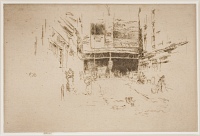Clothes-Exchange, Houndsditch, No. 1 | ||
| Number: | 358 | |
| Date: | 1887 | |
| Medium: | etching and drypoint | |
| Size: | 162 x 242 mm | |
| Signed: | butterfly at left | |
| Inscribed: | no | |
| Set/Publication: | no | |
| No. of States: | 2 | |
| Known impressions: | 12 | |
| Catalogues: | K.287; M.282; W.231 | |
| Impressions taken from this plate (12) | ||
KEYWORD
TITLE
'Clothes Exchange' (1886/1887, Whistler). 2
'Exchange No. 1' (1887, Whistler). 3
'Clothes Exchange No. 1' (1887, Whistler). 4
'Clothes Exchange No. 1, Jew's Quarter, London' (1889, Exposition Universelle). 5
'Old Clothes Exchange' (1899, Frederick Wedmore (1844-1921)). 6
'Exchange. - Houndsditch No 1' (1903/1935, possibly Rosalind Birnie Philip (1873-1958)). 7
'Clothes-Exchange, Houndsditch. No. 1' (1909, Howard Mansfield (1849-1938)). 8
'Clothes-Exchange, No. 1' (1910, Edward Guthrie Kennedy (1849-1932)). 9
The reason for the numbering is that Whistler etched a series of subjects in the area of the Exchange. 'Clothes Exchange, Houndsditch, No. 1' combines the essential elements of titles used by Whistler and later cataloguers. The additional description 'Jew's Quarter, London', given for the Exposition Universelle in 1889, may have met with Whistler's approval but did not meet with general acceptance by later cataloguers.
Houndsditch was and is the most common spelling, although the shorter form of Hounsditch is often used. 10
3: List, [August 1887/1888], GUW #13233.
4: Whistler to T. McLean, 17 November 1887, GUW #13016.
5: Paris Exp. Univ. 1889 (cat.no. 419).
6: Wedmore 1899 (cat. no. 231).
7: Envelope containing copper plate, Hunterian Art Gallery.
8: Mansfield 1909 (cat. no. 282).
9: Kennedy 1910 (cat. no. 287).
10: Thomas Miller, Picturesque Sketches of London, London, 1852; James Greenwood, Journeys; or Byways of the Modern Babylon, London, 1867.
DESCRIPTION
SITE
Phillips & Co., packing case makers, were based in the exchange. Whistler recorded their signboard as reading 'PHILP & Co., PACKERS' (not Philip as read by Mansfield) but this is either a mistake, or a contraction of the name. 11
Henry Mayhew in London Labour and the London Poor recorded the recycling of every scrap of clothing by Londoners. 12 Mayhew described the old market as follows:
11: London Postal Directory, London, 1889.
12: 'Of the Uses of Second-Hand Garments' in London Labour and the London Poor, Vol. 2, London, 1851, at http://www.perseus.tufts.edu (accessed 2008).
13: Henry Mayhew, London Labour and the London Poor, London, 1851.
14: Mayhew 1851, ibid.
15: J. Ewing Ritchie, Here and there in London, London, 1859, pp. 117-123, on-line at http://www.mernick.co.uk (accessed 2008).
16: Henry Mayhew and John Binny, The Criminal Prisons of London and Scenes of London Life (The Great World of London), London, 1862, pp. 39-40.
DISCUSSION
It is interesting that in 1889 it was exhibited as 'Clothes Exchange No. 1, Jew's Quarter, London': it may have had associations for Whistler with the Jewish characters drawn and etched by Rembrandt Harmens van Rijn (1617-1681).

